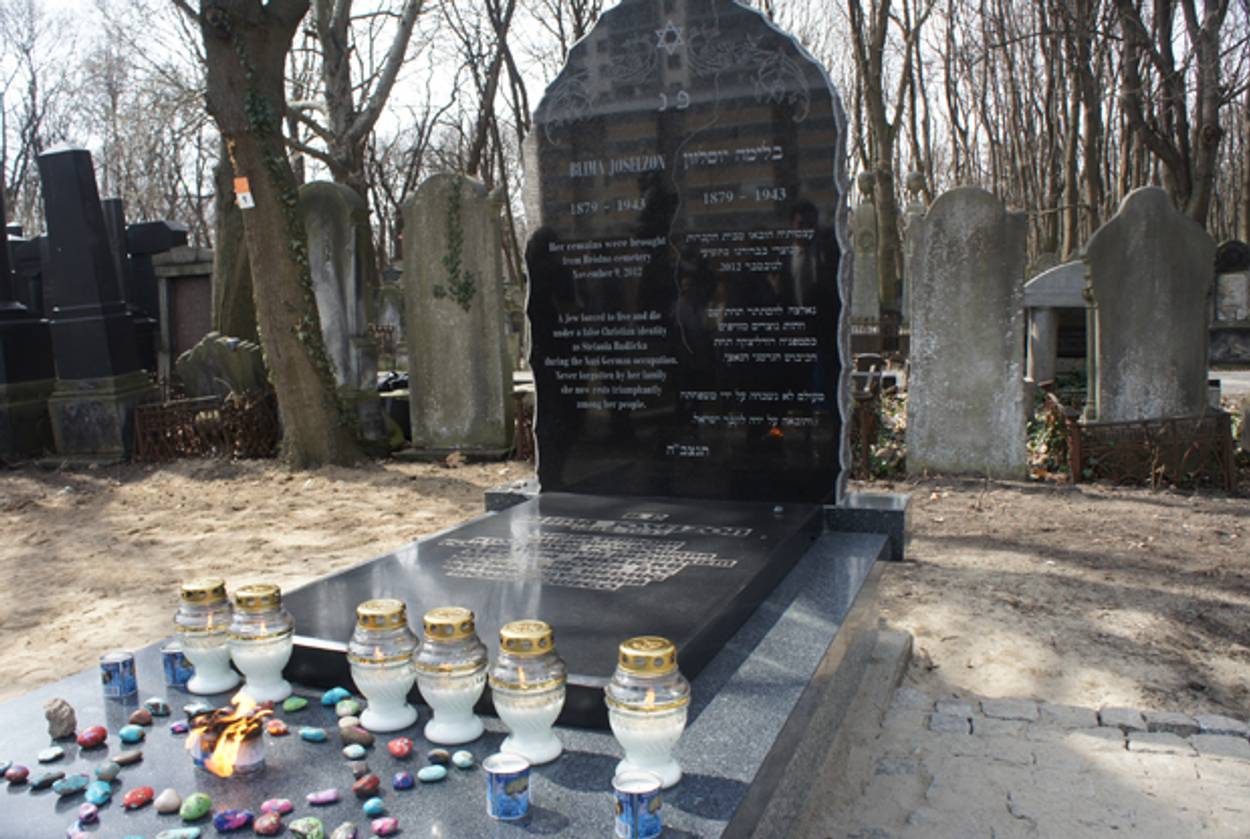The Warsaw Ghetto’s Last Burial
A reburial for a Jewish woman who died in 1943 while hiding as a Catholic




“I want everyone to take a moment,” Michael Schudrich, the chief rabbi of Poland, said to the crowd of about 50 people standing in the sun-filled Jewish cemetery on this unseasonably warm April day in Warsaw. “We’re probably attending the last hakamat ha-matzevah, unveiling of a monument, for someone who died in Warsaw during the war.”
“I don’t think we’re going to have another story like this,” Schudrich added, and members of the group nodded vigorously in agreement. He was right: they were gathered for a rather unusual event—the unveiling of the headstone at the grave of Blima Joselzon, a Jewish woman from Warsaw who died in 1943 while in hiding, and was buried in Warsaw’s Brodno cemetary as Stefania Rudlicka, a Catholic.
“She couldn’t even die as a Jew,” Barbara Blumenthal, 63, one of Joselzon’s two granddaughters, told the crowd this morning. The unveiling marked the end of a complicated, three-year process spearheaded by Blumenthal to move Joselzon’s body into Warsaw’s Okopowa Street Jewish Cemetery, where her husband had been buried.
In 1941, while the family was still living in the Warsaw Ghetto, Blima’s youngest son, Leon, secured hiding spots outside the ghetto for himself, his mother, and his wife, Anya Kotkowski. (His father had died at the start of the war, and was buried in Warsaw’s Jewish cemetery.) He worked in a sewing machine factory owned by a non-Jewish Pole and was able to move more freely than other residents of the ghetto. The hideouts were in ul. Kopernika 4.—a building with a most unusual story. Julian Ambroziewicz, a non-Jewish Warsaw architect, had recently rebuilt the apartment building, and he deliberately designed the building so that the units on each floor were laid out differently—the better to conceal built-in hiding spaces. Leon Jozelson and his family stayed in the two square meter space until the Warsaw Uprising.
But in August 1943, after several months in hiding, Leon’s mother died at the age of 64, leaving the family with the challenge of removing her body without being detected. A Jewish burial was out of the question, but Ambroziewicz brought Joselzon’s body to the Catholic cemetery in a box marked ‘ammunition,’ with the help of members of the Polish resistance, and arranged for her to be buried under the name Stefania Rudlicka.
Leon and Anya Joselzon emigrated to the United States in 1947, where they changed their name to Jolson. In 1977, their daughter Barbara accompanied her parents on their first trip back to Poland. When they returned to the apartment at Kopernika 4, the woman then living there knew exactly who they were, producing a metal box filled with photographs from their time in hiding.
“I had no intention of moving her then,” Barbara told me after today’s ceremony. Instead, they put up a stone marker in the Catholic cemetery identifying Rudlicka as the Jewish woman named Blima Joselzon. In 1993, the stone was broken. Blumenthal blames anti-Semitic vandals; the cemetery cited strong winds. In any case, a replacement stone, laid flat on the ground, was installed.
After her father’s death in August 2009 at the age of 96, Barbara returned to Warsaw. She enlisted Schudrich’s help in gathering a minyan at Brodno to hold a small service by her grandmother’s grave. Disappointed with the site’s lack of visibility, and moved by what she felt was her father’s late-in-life wish that his mother join his father in the Jewish cemetery, Barbara began the process of moving her grandmother’s body.
It was easy to prove that she and her sister were descendents of Blima Joszelson. The biggest obstacle, however, was proving how exactly they were related to a Catholic woman named Stefania Rudlicka. There was a death certificate and a record of her father’s payment for the grave, but no connection between the two women, save for the curious timing.
“It took chutzpah,” she told me, of the battle to prove to the Catholic cemetery that Stefania Rudlicka was Blima Joszelson. It finally worked, and on November 9, 2012, Joselson’s remains were exhumed from Brodno, under the supervision of Schudrich, and reburied in Warsaw’s Jewish cemetery. “There was nothing that was going to stop me,” she told me. During the exhumation, three blue buttons were recovered, part of the sweater Joselzon was buried in.
In attendance this morning was Agata Ambroziewicz, the granddaughter of 4 Kopernika’s Polish architect, and her father, Jan, also an architect. She remembered from a young age hearing the story of the Joselzons from her father, who had known Leon when he was in hiding and remained in touch after he and Anya moved to the United States. Barbara reached out to her and her father a few years ago. “We put the story together,” she told me.
The Joselzon story, however, isn’t over yet. “In a way, it’s an end to a chapter,” Blumenthal told me after the ceremony. “But I feel it’s a beginning of a whole new thing.” Her next step is to restore and preserve her parents’ hiding place at 4 Kopernika.
“A resting place should be for peace and a blessing,” Schudrich said as he concluded the ceremony. “It took 70 years, but Blima is now at peace.”
Stephanie Butnick is chief strategy officer of Tablet Magazine, co-founder of Tablet Studios, and a host of the Unorthodox podcast.